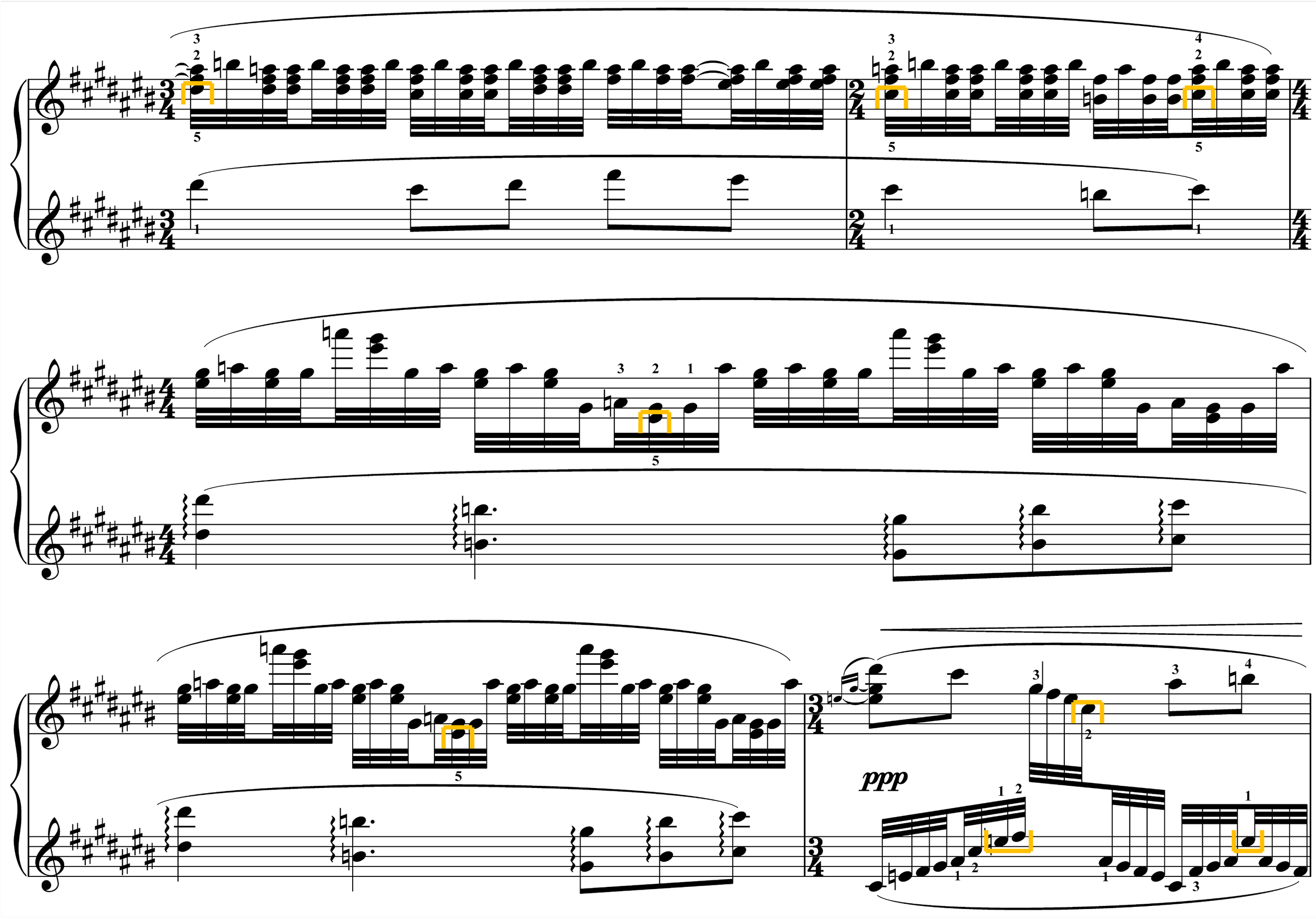“I find it easier to stop dividing the hands in mm. 4–5 and take the thirds as double notes rather than leap around.”
Submitted by Michael Clark
Published on 3/16/2020

“I find it easier to stop dividing the hands in mm. 4–5 and take the thirds as double notes rather than leap around.”
Submitted by Michael Clark
Published on 3/16/2020

“This redistribution makes the right-hand shifts less awkward, allowing the line to be played with stronger fingers.”
Submitted by Michael Clark
Published on 3/16/2020

“I stagger the leaps where possible by taking some thirds as double notes.”
Submitted by Michael Clark
Published on 3/16/2020

Submitted by Bang Hean Loo
Published on 5/22/2025
“This arrangement enables the thirds to sound much smoother.”

“With the left hand's help, legato in all voices is possible.”
Submitted by Michael Clark
Published on 4/18/2020

“This redistribution is designed to achieve maximum legato.”
Submitted by Michael Clark
Published on 1/1/2020
Original:

Suggested performance:

Submitted by Michael Lenahan
Published on 1/1/2020

“Repeat provided fingering patterns through the measure.”
Submitted by Kevin Lee Sun
Published on 1/28/2022

“The left hand is unencumbered with double notes and can assist the right hand.”
Submitted by Michael Clark
Published on 1/1/2020

“No need to stress over these huge leaps when the F-sharps are within easy reach of the left hand. The configuration of the double notes in this passage require a slightly different distribution than earlier in the piece.”
Submitted by Michael Clark
Published on 1/1/2020

“The bottom notes of these sixths fit easily into the left hand.”
Submitted by Michael Clark
Published on 3/17/2020

“These quick sixths are more reliably and smoothly played with two hands.”
Submitted by Michael Clark
Published on 3/15/2020
Fingerings in Italics are Liszt’s.

“I find that this hand distribution on the arpeggio feels good and looks good.”
Submitted by Michael Clark
Published on 1/1/2020

“I achieve better evenness and clarity when I divide the fourths between the hands in m. 35. Taking the lower note of the top staff into the left hand in mm. 37–39 allows me to sustain everything without excess stretching.”
Submitted by Michael Clark
Published on 1/5/2024

“I split up the thirds for ease, clarity, and optimal articulation.”
Submitted by Michael Clark
Published on 1/6/2024

“Dividing the augmented triads in this way feels the most secure to me.”
Submitted by Michael Clark
Published on 9/1/2023

“The most straightforward way to play the double notes would be 5-3 4-2 3-1. However, using 5-1 4-2 3-1 provides better support and power to execute the accents. It also improves the clarity and prevents potential sloppiness.”
Submitted by Jimmy Cheung
Published on 4/27/23

SPECIAL COLLECTION | Dorothy Brandwein’s Ravel Fingerings
Published on 4/4/2022 with the author’s permission
First appeared in Dorothy Woster Brandwein, "Divisi Fingering in Selected Passages from Ravel's Solo Piano Works" (DMA diss., University of Missouri–Kansas City, 1981), 26, 29, 93.
26–27: “Constant thirty-second note figurations provide an undercurrent of sound throughout ‘Ondine.’ Measures like those in Example 6 can be played smoothly and with less effort when the notes are taken by the hand closest to them… The above measures, as well as those in Example 7, illustrate a consistency in the note patterns and their fingerings.”
29: “A recurring harmonic figuration in "Ondine" which encompasses two or three octaves presents an extreme problem for the right hand [mm. 15–16]. The difficulty is the rapid shift of the thumb required at the bottom of the pattern which propels the hand back up to the top. These shifts can nearly always be avoided by playing the lowest note of the pattern with the left hand.”
93, fn10: "The pianist must be careful that this divisi fingering does not interrupt the flow of the melody on the lower staff [mm.13–14]."